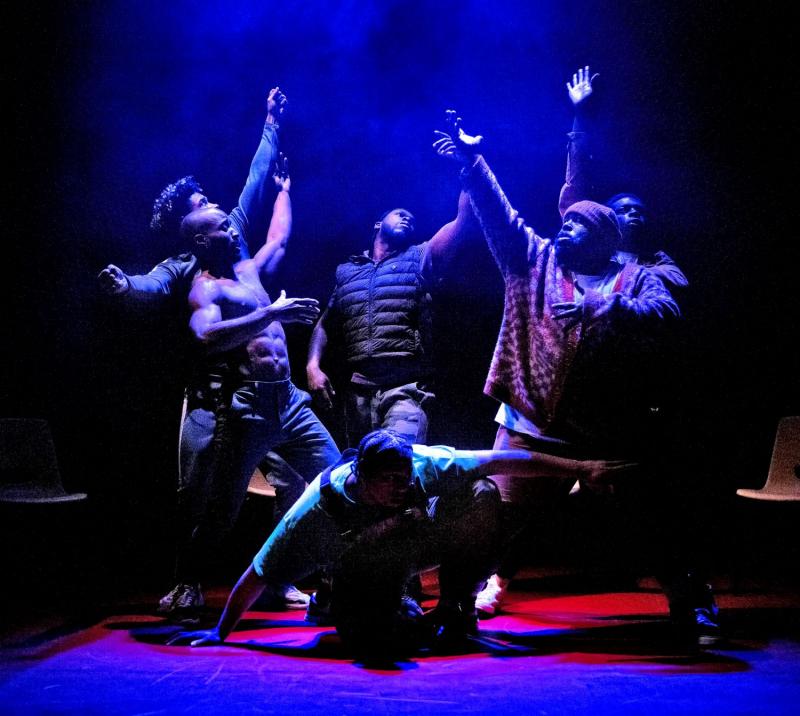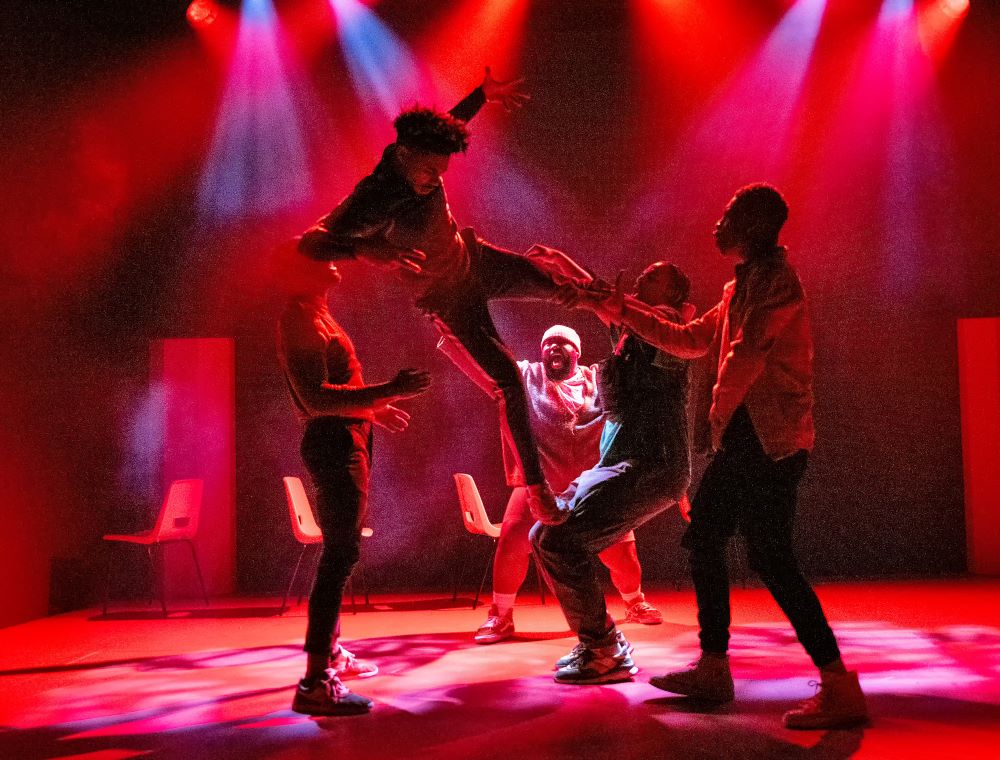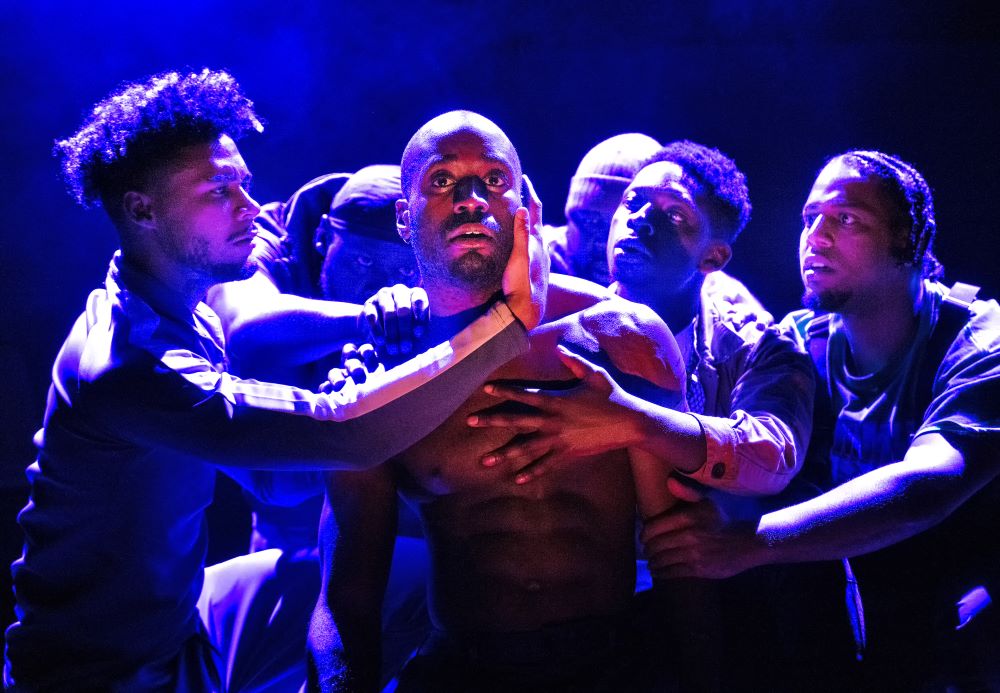For Black Boys Who Have Considered Suicide When The Hue Gets Too Heavy, Royal Court review - Black joy, pain, and beauty | reviews, news & interviews
For Black Boys Who Have Considered Suicide When The Hue Gets Too Heavy, Royal Court review - Black joy, pain, and beauty
For Black Boys Who Have Considered Suicide When The Hue Gets Too Heavy, Royal Court review - Black joy, pain, and beauty
With boisterous lyricism, Ryan Calais Cameron explores what it means to be a Black man

The title is so long that the Royal Court’s neon red lettering only renders the first three words, followed by a telling ellipsis. But lyrical new play For Black Boys Who Have Considered Suicide When the Hue Gets Too Heavy lives up to its weighty name.
Writer-director Ryan Calais Cameron shows us Black masculinity in all its nuances and contradictions, presented by six actors so naturally charming it’s impossible not to fall in love with them. This is an odyssey through Black masculinity, a complex navigation of a sea of troubles and expectations and joy and love. Line by line, each man’s soul is coaxed to the surface through the stories they tell their peers, laying bare the trauma beneath the bravado.
We start with Jet (Nnabiko Ejimofor) on the playground, wondering why none of the girls go for him when they play kiss chase. The most popular (white) boy in the school takes him under his wing, which six-year-old Jet is thrilled by: “this was before I knew White saviour complex was a ting.” Each character is colour-coded: blue, yellow, orange, red, purple, green. Anna Reid’s set is, too, with plastic primary-school chairs and vibrant walls. The effect emphasises the Black boys’ youth – for some, this is their stage debut. It’s also an element that Cameron has transferred from the inspiration for his play, Ntozake Shange’s For Colored Girls Who Have Considered Suicide/When the Rainbow is Enuf. Like Shange’s Black girls, Cameron’s boys tag each other into the spotlight, goaded into talking through their trauma even when they’re not quite ready for it.
The effect emphasises the Black boys’ youth – for some, this is their stage debut. It’s also an element that Cameron has transferred from the inspiration for his play, Ntozake Shange’s For Colored Girls Who Have Considered Suicide/When the Rainbow is Enuf. Like Shange’s Black girls, Cameron’s boys tag each other into the spotlight, goaded into talking through their trauma even when they’re not quite ready for it.
The characters are named for shades of black, for the heavy hue they can’t set down. There’s anxious Pitch (Emmanuel Akwafo), academic Obsidian (Aruna Jalloh), flirty Sable (Darragh Hand), boisterous Midnight (Kaine Lawrence). In bits and pieces, through jokes and rap and rhythm, the boys show their soft underbellies: lack of confidence, low self-esteem, childhood sexual abuse. Onyx (Mark Akintimehin) is the least interested in being vulnerable – or at least, he seems that way at first. His intimidating swagger only cracks when he and Jet begin to act out each other’s father-son dynamics, and it becomes clear just how badly Onyx was treated as a child.
For Black Boys… premiered at the New Diorama Theatre on the corner of Regent’s Park in 2021. Maybe because of being (presumably) written in lockdown, it’s bursting with energy. The individuals are excellent – Lawrence’s heartbreaking reveal of Midnight’s childhood trauma is a standout – but the collective is what’s powerful, here. The myriad dance sequences and singing fit right in, unspooling naturally from the characters’ monologues. There’s an edge to them, though – in a world where Black mannerisms have been copied and twisted for non-Black amusement, the boys remind us that they are singing and dancing for themselves and each other first, and their audience second. It must be almost overwhelmingly cathartic, to perform this show as a Black man, saying the words of a Black man, about Black men. They don’t always agree with each other, of course. At several points, Obsidian reaches towards the other boys’ dance and pulls it down like an imaginary curtain, forcing them to stop and pay attention to what he wants to talk about. “You’re ruining it!” he insists, when Onyx wants to joke around. Through these six contrasting characters, Cameron is trying to work out what he thinks about being a Black man.
They don’t always agree with each other, of course. At several points, Obsidian reaches towards the other boys’ dance and pulls it down like an imaginary curtain, forcing them to stop and pay attention to what he wants to talk about. “You’re ruining it!” he insists, when Onyx wants to joke around. Through these six contrasting characters, Cameron is trying to work out what he thinks about being a Black man.
The confessors’ instinct when they are visibly emotional is to push hands away, but the others resist this, touching shoulders, cupping faces, pressing foreheads to their brothers’ backs. This is what will save them: connection, which stems from vulnerability. Gentle touch, in a world which tries its best to make them brutal. They are each other’s friends, brothers, fathers – even lovers. Ejimofor and Akwafo play out an achingly tender love story in a club, which melts away with the sunrise because their culture sees “homosexuality as a White man’s perversion.”
That glowing red version of the title becomes a neat summary. This play is for Black boys, for the Black boy Cameron was and the Black boys his sons are, for the Black men hiding Black boys inside them. The cast are visibly emotional at the play’s climax, where the characters assert themselves and their humanity. We emerge into a bar filled with portraits of Black boys beaming from ear to ear, as if they’ve been listening in.
rating
Explore topics
Share this article
The future of Arts Journalism
You can stop theartsdesk.com closing!
We urgently need financing to survive. Our fundraising drive has thus far raised £49,000 but we need to reach £100,000 or we will be forced to close. Please contribute here: https://gofund.me/c3f6033d
And if you can forward this information to anyone who might assist, we’d be grateful.

Subscribe to theartsdesk.com
Thank you for continuing to read our work on theartsdesk.com. For unlimited access to every article in its entirety, including our archive of more than 15,000 pieces, we're asking for £5 per month or £40 per year. We feel it's a very good deal, and hope you do too.
To take a subscription now simply click here.
And if you're looking for that extra gift for a friend or family member, why not treat them to a theartsdesk.com gift subscription?
more Theatre
 The Weir, Harold Pinter Theatre review - evasive fantasy, bleak truth and possible community
Three outstanding performances in Conor McPherson’s atmospheric five-hander
The Weir, Harold Pinter Theatre review - evasive fantasy, bleak truth and possible community
Three outstanding performances in Conor McPherson’s atmospheric five-hander
 Dracula, Lyric Hammersmith review - hit-and-miss recasting of the familiar story as feminist diatribe
Morgan Lloyd Malcolm's version puts Mina Harkness centre-stage
Dracula, Lyric Hammersmith review - hit-and-miss recasting of the familiar story as feminist diatribe
Morgan Lloyd Malcolm's version puts Mina Harkness centre-stage
 The Code, Southwark Playhouse Elephant review - superbly cast, resonant play about the price of fame in Hollywood
Tracie Bennett is outstanding as a ribald, riotous Tallulah Bankhead
The Code, Southwark Playhouse Elephant review - superbly cast, resonant play about the price of fame in Hollywood
Tracie Bennett is outstanding as a ribald, riotous Tallulah Bankhead
 Reunion, Kiln Theatre review - a stormy night in every sense
Beautifully acted, but desperately grim drama
Reunion, Kiln Theatre review - a stormy night in every sense
Beautifully acted, but desperately grim drama
 The Lady from the Sea, Bridge Theatre review - flashes of brilliance
Simon Stone refashions Ibsen in his own high-octane image
The Lady from the Sea, Bridge Theatre review - flashes of brilliance
Simon Stone refashions Ibsen in his own high-octane image
 Romans: A Novel, Almeida Theatre review - a uniquely extraordinary work
Alice Birch’s wildly epic family drama is both mind-blowing and exasperating
Romans: A Novel, Almeida Theatre review - a uniquely extraordinary work
Alice Birch’s wildly epic family drama is both mind-blowing and exasperating
 The Producers, Garrick Theatre review - Ve haf vays of making you laugh
You probably know what's coming, but it's such great fun!
The Producers, Garrick Theatre review - Ve haf vays of making you laugh
You probably know what's coming, but it's such great fun!
 Not Your Superwoman, Bush Theatre review - powerful tribute to the plight and perseverance of Black women
Golda Rosheuvel and Letitia Wright excel in a super new play
Not Your Superwoman, Bush Theatre review - powerful tribute to the plight and perseverance of Black women
Golda Rosheuvel and Letitia Wright excel in a super new play
 Cow | Deer, Royal Court review - paradox-rich account of non-human life
Experimental work about nature led by Katie Mitchell is both extraordinary and banal
Cow | Deer, Royal Court review - paradox-rich account of non-human life
Experimental work about nature led by Katie Mitchell is both extraordinary and banal
 Deaf Republic, Royal Court review - beautiful images, shame about the words
Staging of Ukrainian-American Ilya Kaminsky’s anti-war poems is too meta-theatrical
Deaf Republic, Royal Court review - beautiful images, shame about the words
Staging of Ukrainian-American Ilya Kaminsky’s anti-war poems is too meta-theatrical
 Laura Benanti: Nobody Cares, Underbelly Boulevard Soho review - Tony winner makes charming, cheeky London debut
Broadway's acclaimed Cinderella, Louise, and Amalia reaches Soho for a welcome one-night stand
Laura Benanti: Nobody Cares, Underbelly Boulevard Soho review - Tony winner makes charming, cheeky London debut
Broadway's acclaimed Cinderella, Louise, and Amalia reaches Soho for a welcome one-night stand
 The Pitchfork Disney, King's Head Theatre review - blazing with dark energy
Thrilling revival of Philip Ridley’s cult classic confirms its legendary status
The Pitchfork Disney, King's Head Theatre review - blazing with dark energy
Thrilling revival of Philip Ridley’s cult classic confirms its legendary status

Add comment